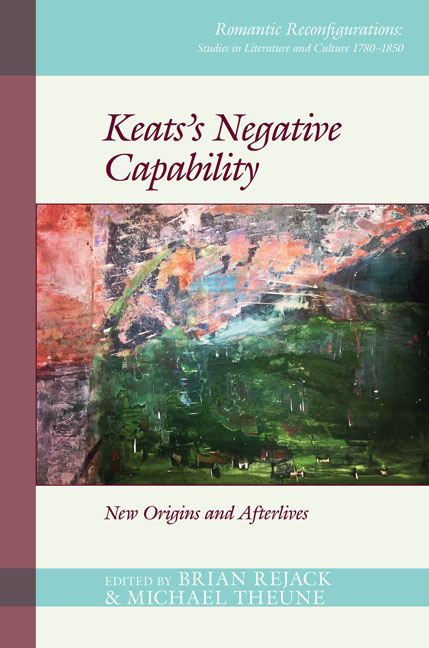Book contents
- Frontmatter
- Contents
- List of Figures
- Acknowledgments
- List of Abbreviations
- List of Contributors
- Preface
- Introduction: Disquisitions: Reading Negative Capability, 1817–2017
- Part I ‘swelling into reality’: New Contexts for Negative Capability
- Part II ‘examplified throughout’: Forms of Negatively Capable Reading
- Part III ‘pursued through Volumes’, Volume I: Negative Capability in Twentieth- and Twenty-First-Century American Poetry
- Part IV ‘pursued through Volumes’, Volume II: Adaptations, Appropriations, Mutations
- Afterword: Reading Keats's Negative Capability
- Bibliography
- Index
Introduction: Disquisitions: Reading Negative Capability, 1817–2017
- Frontmatter
- Contents
- List of Figures
- Acknowledgments
- List of Abbreviations
- List of Contributors
- Preface
- Introduction: Disquisitions: Reading Negative Capability, 1817–2017
- Part I ‘swelling into reality’: New Contexts for Negative Capability
- Part II ‘examplified throughout’: Forms of Negatively Capable Reading
- Part III ‘pursued through Volumes’, Volume I: Negative Capability in Twentieth- and Twenty-First-Century American Poetry
- Part IV ‘pursued through Volumes’, Volume II: Adaptations, Appropriations, Mutations
- Afterword: Reading Keats's Negative Capability
- Bibliography
- Index
Summary
Fortunately for those of us invested in the literary career of John Keats generally, and in negative capability specifically, one day in May 1845 an accomplished Scottish engineer—who was responsible for bringing gas lighting to the streets of many Midwestern and Southeastern cities in the United States, including Louisville, Kentucky, where he then resided—sat down to read the newspaper and came across a notice like this one: ‘A Life of Keats is preparing by Monckton Milner, M. P., himself a good poet’. ‘Milner’ referred to Richard Monckton Milnes, the person who was at the time gathering materials for a biography of the poet (a project which Keats's friends had failed to make happen in the years since his death). The Scottish engineer was John Jeffrey, who two years earlier had married Georgiana Wylie Keats, the poet's sister-inlaw, who had emigrated to America with her husband George in 1818 and been widowed in December 1841. Jeffrey thought that, with his access to the Keats family papers, he might try ‘arranging them for publication some of these days when I have a little more leisure’ (KC, II: p. 114). Milnes beat him to it. At least as early as January 1845, notices announcing Milnes's intentions to publish the biography of Keats began appearing in British newspapers and, soon thereafter, versions of those notices had made it into American newspapers; the longer notices even specifically mentioned that ‘all the necessary papers have been placed in [Milnes’s] hands by the family’. Jeffrey would have immediately realized, since he himself had not been contacted by Milnes, that not all the necessary papers had made their way to Milnes's hands. As Jeffrey wrote to Milnes on 13 May 1845, he had, through his marriage to Georgiana, ‘become possessed of papers & information relative to the poet Keats, without which, it is impossible in my opinion to give his complete life’ (KC, II: p. 117). One of those papers was the letter Keats sent to his brothers George and Tom in December 1817, and which contained the term around which the essays in this volume revolve: negative capability.
- Type
- Chapter
- Information
- Keats's Negative CapabilityNew Origins and Afterlives, pp. 1 - 12Publisher: Liverpool University PressPrint publication year: 2019

